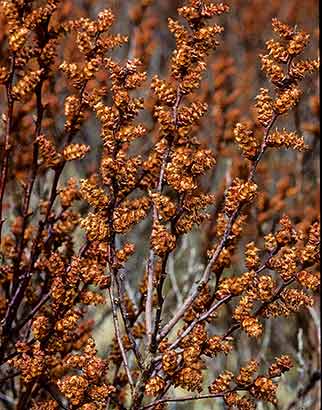Bog myrtle (Myrica gale)
When: All year round
How many: Relatively abundant and fairly widespread

Though very often relatively inconspicuous, bog myrtle is worth searching out. Pluck a number of bog myrtle leaves, rub them between your fingers, and enjoy a delightfully aromatic, eucalyptus-like scent that gives bog myrtle its country name: sweet gale. Bog myrtle stems also have the same attractive aroma which derives from a resinous substance exuded by multitudes of tiny yellow glands.
Common and widespread around New Forest wetland edges, bog myrtle is a low, woody, catkin-bearing shrub that reaches a height of 60-90 centimetres (24-36 inches). Bog myrtle seems to be unpalatable to commoners’ stock, and is largely left alone to form extensive, sometimes dense, impassable stands.
Quite long, narrow, dark green bog myrtle leaves grow on wiry, reddish-brown stems. Male and female catkins are usually found on separate plants – male catkins are paler than the distinctly reddy/orange, wind-pollinated females. The bog myrtle flowering period is from April to May.
Bog myrtle obtains its nitrogen, a colourless gas essential for plant life but not readily available in water-logged conditions, through an association with soil-borne bacteria.
John Wise, writing of the New Forest in the mid-19th century, fittingly referred to bog myrtle as ’the gold withy of the New Forest’, whilst John Gerard in The Herball, or General Historie of Plantes, first published in 1597, noted that bog myrtle gave a headiness to beer or ale, which was then ‘fit to make a man quickly drunke’.
A sprig of bog myrtle carried about the head is said to keep away midges, and it is still used as an ingredient in a commercially available insect repellent. The alternative name flea-wood refers to an ability to drive away fleas.
References:
Collins New Generation Guide - Wild Flowers of Britain and Northern Europe: Alastair Fitter
Reader’s Digest Field Guide to the Wild Flowers of Britain
The Englishman’s Flora: Geoffrey Grigson
The Herball or General Historie of Plantes: John Gerard
The New Forest: Its History and Scenery: John R. Wise
More links
Other related links
Search this site

Sadly, 58 animals were killed - 35 ponies, 13 cows, 8 donkeys and 2 sheep, whilst a further 32 were injured - 3 pigs, 9 donkeys, 11 cows and 9 ponies.
(Forty-three accidents occurred in daylight, 15 at twilight and 101 in the dark. Twenty-seven accidents were not reported by the driver involved).
Here's just one horrific example - Three donkeys killed in collision with van at notorious New Forest blackspot (Advertiser and Times)

